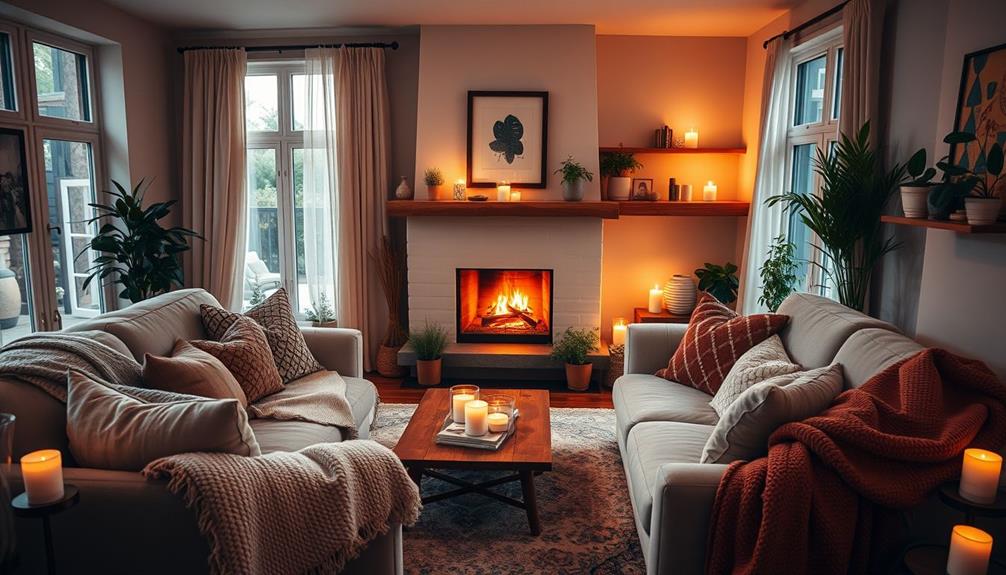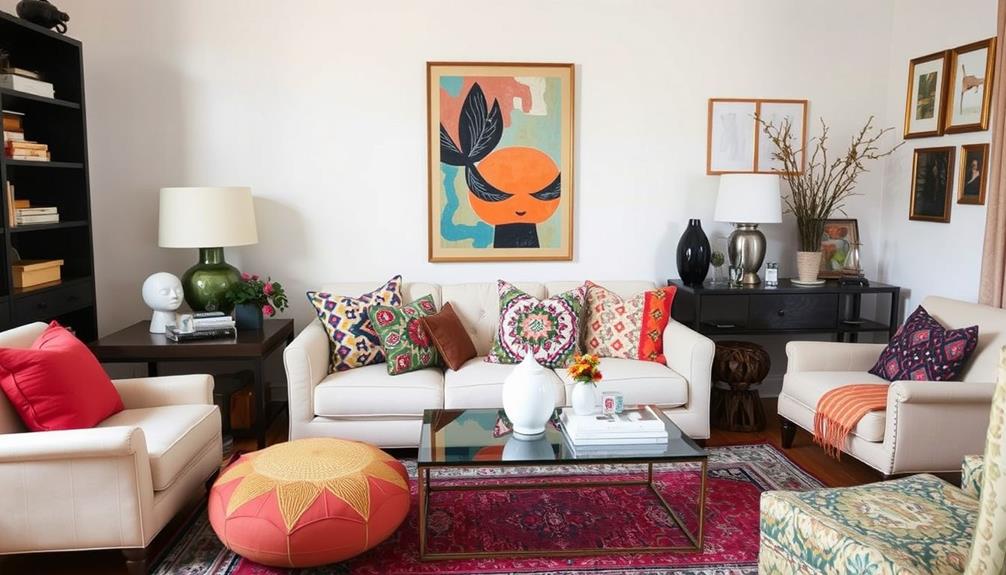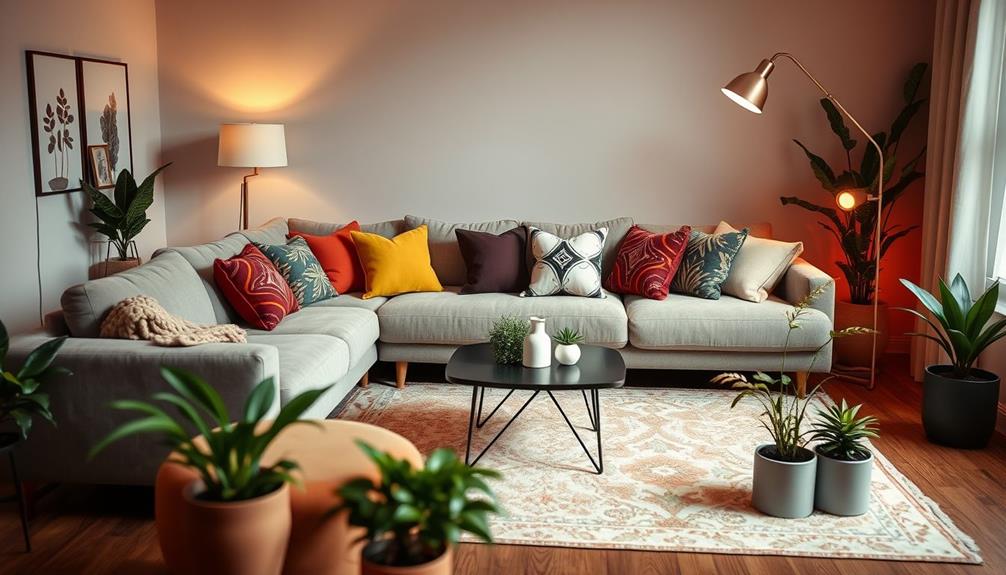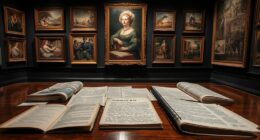To design your living room, start by measuring the space to guarantee your furniture fits correctly. Choose a calming color palette using the 60/30/10 rule for balance. Create a vision board with inspiring images to maintain focus. Prioritize key pieces like sofas and rugs, opting for individual items that complement each other. Arrange furniture to promote conversation and guarantee comfortable movement. Layer textures with throw pillows and rugs for a cozy feel, and use varied lighting to enhance ambiance. Finally, incorporate personal accessories to make the space uniquely yours. There's so much more to explore as you refine your design! Consider small bedroom design tips to optimize your use of space, such as utilizing multifunctional furniture and clever storage solutions. Incorporate mirrors to create the illusion of a larger room, and use light, neutral colors to make the space feel open and airy. Remember to keep the overall feel of the room cohesive with the rest of your home’s design aesthetic. With these tips in mind, you can create a harmonious and cozy living room that reflects your personal style and enhances your everyday life.
Key Takeaways
- Measure your living room space and outline potential furniture placements with painter's tape to avoid sizing issues.
- Establish a cohesive aesthetic by selecting a calming color palette and following the 60/30/10 rule for color distribution.
- Create a vision board with inspiring images to maintain design focus and assess interactions among chosen elements.
- Prioritize foundational furniture pieces and opt for multi-functional options to accommodate lifestyle needs and maximize space.
- Incorporate diverse textures and seasonal fabric updates to enhance comfort and visual interest in the living room.
Initial Planning and Measurement

When kickstarting your living room design, measuring the space is essential. Start by determining the square footage of your living room to guarantee all furniture and decor fit appropriately.
Pay close attention to walls with windows, doors, or recesses, as these elements can greatly impact your layout and flow. Accurate measurements during initial planning will save you time and money by preventing missteps later on.
As you shop for furniture, bring a measurement sketch to avoid purchasing items that are too large or small for designated areas. This proactive approach helps maintain balance and functionality within your space.
To visualize potential rug sizes, use painter's tape to outline dimensions on the floor, guaranteeing that the front legs of your main furniture rest on the rug for a cohesive look.
Establishing Aesthetic and Color Palette

Creating a cohesive aesthetic and color palette is essential for a well-designed living room. Start by choosing a calming color palette that enhances your overall aesthetic. Consider using neutral tones as your base, then add in accent colors to streamline your decor choices. This approach not only fosters design cohesion but also simplifies the selection of prints and textiles.
Keep in mind the emotional impact of colors; warmer tones create a cozy atmosphere, while cooler colors evoke calm and tranquility. To achieve visual harmony, balance is key. Use the 60/30/10 rule for color distribution:
| Color Role | Percentage |
|---|---|
| Dominant Color | 60% |
| Secondary Color | 30% |
| Accent Color | 10% |
Additionally, gather at least 10 inspiring images that reflect your preferred style. This visual reference will guide your selections and guarantee your living room maintains a unified aesthetic. By carefully considering your color palette and its emotional effects, you can create a living space that feels both inviting and harmonious.
Creating a Vision Board

Creating a vision board is essential for visual planning, as it helps you clarify your design ideas and preferences.
Start by selecting at least 10 inspiring images that resonate with your style, and then assess how these elements interact with one another.
This process not only refines your choices but also guarantees that everything works together harmoniously in your living room.
Importance of Visual Planning
A vision board is essential for effective visual planning in interior design, as it allows you to see how different elements interact before committing to purchases. By curating images of furniture, colors, and accessories, you can establish a cohesive aesthetic that unifies your space.
Incorporating stylish wall clocks or enchanting pendant lights can enhance your vision board, providing inspiration for blending functionality with aesthetics. This clarity not only enhances the design process but also helps you identify potential design mistakes early on, saving you time and money.
Creating a vision board fosters creativity, encouraging you to explore different textures, styles, and layouts that resonate with your personal taste. As you gather at least ten inspiring images, you'll find it easier to visualize your ideas and make confident decisions about your living room's decor.
Throughout the decorating process, your vision board serves as a practical reference, keeping your design goals clear and focused. It reminds you of the overall direction you want to take, ensuring that every purchase aligns with your established aesthetic.
Ultimately, a vision board is a powerful tool that guides your choices and ignites your creativity, making the interior design journey enjoyable and successful.
Selecting Inspiring Images
Selecting inspiring images is an essential step in developing your vision board for your living room. Start by gathering at least ten images that reflect your desired aesthetic. This process helps establish a cohesive design direction, guaranteeing everything works harmoniously together.
Use platforms like Pinterest and Houzz to find and curate images that resonate with your style preferences. Look for a diverse mix of layouts, colors, and decor elements that inspire you.
As you select these inspiring images, consider how different pieces interact visually. This can help you identify potential design mistakes early on, saving you time and effort later. A well-constructed vision board serves as a visual reference throughout your decorating process. It keeps you aligned with your overall design goals and color palette.
Don't hesitate to regularly assess and adjust your vision board as you discover new inspirations or refine your style. This adaptability guarantees your vision board continues to guide your living room design effectively, helping you create a space that truly reflects your personality and taste.
Assessing Design Interactions
Once you've gathered your inspiring images, it's time to assess how they interact within your vision board. This visual representation helps you see how different decor choices fit together, ensuring a cohesive look. Start by arranging your images to evaluate color harmony, texture, and style. This fine-tuning will help you identify potential design mistakes before you make any purchases.
Here's a simple table to help you assess these elements:
| Aspect | Considerations |
|---|---|
| Color Harmony | Do the colors complement or clash? |
| Texture | Are textures varied yet harmonious? |
| Style | Is there a consistent style throughout? |
| Functionality | Does the layout facilitate usability? |
| Overall Vibe | Does it evoke the desired mood? |
Using your vision board, experiment with different combinations, whether digitally or through a physical collage. Early identification of design mistakes can save you time and money, allowing for necessary adjustments. By ensuring all elements on your vision board complement each other, you'll create a beautiful and functional living room that reflects your style.
Shopping for Key Pieces

As you commence on the journey of shopping for key pieces, prioritizing foundational items like sofas and rugs is essential since they set the tone for your living room design.
When selecting a sofa, think about its functionality based on your lifestyle needs. Do you need pet-friendly materials or enough seating for family gatherings? These considerations will guarantee comfort and quality in your choices.
Additionally, consider incorporating statement decor pieces for impact, which can enhance the overall aesthetics of your space, making it feel more personalized and inviting. This approach aligns well with the idea of a living room transformation.
Avoid the common design mistakes of purchasing matching furniture suites. Instead, look for individual pieces that complement each other in style and color. This approach creates a more sophisticated and personalized look, allowing each item to shine.
To manage costs effectively, stagger your shopping. This strategy allows for thoughtful purchases that enhance long-term satisfaction, steering clear of impulse buys that might lead to regret later.
Lastly, utilize vision boards or mood boards to visualize how your selected pieces interact. This can help you catch potential design mistakes early on, guaranteeing your living room reflects your unique style and meets your functional needs.
Optimizing Furniture and Rugs

When optimizing your living room, the right arrangement of furniture and rugs can make a huge difference.
Start by ensuring your rug is sized properly so that the front legs of your main furniture pieces sit on it, creating a cohesive look.
Remember to choose multi-functional furniture to enhance utility while maintaining clear pathways for easy movement.
Furniture Arrangement Tips
Arranging furniture effectively in your living room can transform the space into a welcoming and functional area. To optimize your furniture arrangement, keep these tips in mind: Incorporating elements of modern farmhouse decor trends can enhance the aesthetic of your living room, emphasizing natural materials and neutral color palettes.
- Define the seating area: Ascertain all main furniture pieces, like sofas and chairs, have their front legs resting on a large area rug. This creates a cohesive look and clearly defines the conversation space.
- Maintain clear walkways: Keep walkways of at least 16-18 inches between furniture. This facilitates easy movement and prevents overcrowding, making the room feel more open and inviting.
- Encourage conversation: Arrange seating in a U or L shape around a central coffee table to promote interaction. This layout encourages guests to engage, making your living room a hub for socializing.
Don't forget to reflect on multi-functional furniture, such as nesting tables or ottomans, to maximize utility while keeping the atmosphere organized.
Using painter's tape to visualize rug dimensions and furniture placement can also help avoid sizing mistakes that disrupt balance.
With these tips, your living room won't only look great but also feel inviting for you and your guests.
Rug Sizing Guidelines
Selecting the right rug is key to enhancing your living room's design and ensuring a cohesive look. When it comes to rug sizing guidelines, make sure the front legs of all main furniture pieces rest on the rug. This not only defines your seating area but also creates a unified feel throughout the space.
Aim for a rug size that maintains 10-20 inches of bare floor between the edges of the rug and the walls. This approach enhances room proportions and prevents a cramped appearance. To visualize the perfect size, use painter's tape to outline the dimensions on your floor, helping you avoid purchasing an incorrectly sized rug.
Small rugs can make your living area feel disjointed, so opt for larger rugs that encompass your main furniture layout. If you're interested in layering rugs, remember that the base rug needs to be large enough to accommodate your primary furniture arrangement for a harmonious design.
Multi-Functional Furniture Options
Multi-functional furniture can transform your living room into a space that's both stylish and practical. By choosing pieces that serve multiple purposes, you can maximize storage and minimize clutter, creating an inviting environment.
Contemplate incorporating some cozy teenage girl room colors for a warm ambiance that enhances comfort.
Here are three great options to contemplate:
- Sofa Beds: These versatile pieces provide comfortable seating by day and a cozy sleeping solution for overnight guests, maintaining room functionality.
- Nesting Tables: Perfect for flexible arrangements, nesting tables can easily adjust in size and be rearranged as needed, expanding surface area for gatherings or simply tucking away when not in use.
- Modular Sofas: Opt for modular sofas that can be reconfigured to suit various activities, from movie nights to game sessions. Their adaptability allows you to create different layouts with ease.
Incorporating these multi-functional furniture options not only enhances the usability of your living room but also adds visual interest.
Think about utilizing bookshelves as room dividers for additional storage while defining separate zones, making your space more organized and inviting.
Embrace these ideas to maximize your living area effectively.
Enhancing Surfaces and Decor

To truly elevate your living room's atmosphere, it's essential to thoughtfully enhance the surfaces and decor. Start by evaluating available surfaces like coffee tables, shelves, and mantels. Create intentional decor vignettes that enhance visual interest while serving a functional purpose.
Incorporate a mix of decorative items such as vases, books, and candles to establish focal points that reflect your personal style and add character to the space. Additionally, consider adding elements like well-draining soil for potted plants, as they can bring a touch of nature indoors and improve air quality.
Don't shy away from using personal items, like family photos or travel souvenirs, to customize these surfaces. This approach makes your living room feel inviting and connected to your life experiences.
Layering textures through various materials, including ceramics, metals, and fabrics, can also create depth and warmth in your decor, enhancing the overall atmosphere of the room.
To keep things fresh and engaging, regularly rotate decorative items and update surfaces with seasonal accessories. This not only allows for easy personalization but also introduces variety, ensuring your living room remains a dynamic space.
Utilizing Textures and Fabrics

To create a cozy and inviting living room, you'll want to layer different textures strategically.
Incorporating seasonal fabric updates, like switching to lighter materials in warmer months, can keep your space feeling fresh and dynamic.
With the right mix of textures and fabrics, you can notably enhance both the comfort and aesthetic of your room.
Layering Textures Strategically
Layering textures in your living room can transform the space into a cozy retreat.
By combining various materials, you can create an inviting atmosphere that captivates the senses. Incorporating elements like aesthetic candles can further enhance the ambiance while adding a sensory dimension with their scents.
Here are three effective ways to layer textures for maximum visual interest:
- Combine Soft and Plush Elements: Use soft throws and plush pillows to add comfort. Opt for different fabrics like velvet and linen to enhance the tactile experience.
- Incorporate Textured Elements: Introduce a shaggy rug or a knitted blanket. These textured elements break up visual monotony and provide a dynamic quality to your decor.
- Mix Smooth and Rough Surfaces: Pair a sleek leather couch with a chunky knit throw. This contrast creates a balanced and visually appealing design, making the living room feel more inviting.
Seasonal Fabric Updates
Updating fabrics seasonally breathes new life into your living room, making it feel fresh and inviting. You can easily refresh the aesthetic by swapping out lighter fabrics, like linens and cottons, for spring and summer, and shifting to heavier textiles, such as velvets and wools, during fall and winter. This not only enhances warmth but also adds a cozy atmosphere.
Additionally, consider how your HVAC system can benefit from regular maintenance during these seasonal changes, as it can improve comfort levels and maintain air quality within your living space importance of HVAC maintenance.
Utilizing a mix of textures through pillows, throws, and curtains introduces depth to your decor, inviting tactile comfort that makes the space feel more welcoming. Seasonal fabric updates allow you to keep your living room current without a complete redesign, providing a cost-effective solution to stay aligned with trends.
Incorporate seasonal colors through your fabrics to evoke the essence of each season. Think pastel hues for spring and rich jewel tones for winter, enhancing the room's mood.
Layering fabrics, like combining patterned throws with solid cushions, creates visual interest and complexity, making your living room dynamic and appealing throughout the year. Embrace these seasonal fabric updates, and watch your living space transform with each new season.
Focusing on Lighting

When designing your living room, focusing on lighting is essential for creating a warm and inviting atmosphere. To achieve this, incorporate three types of lighting:
- Ambient Lighting – This is your primary source of light, providing overall illumination. Think overhead fixtures or soft wall sconces.
- Task Lighting – Position lamps at eye level when seated to guarantee ideal lighting for activities like reading or socializing.
- Accent Lighting – Use unique light fixtures to highlight artwork or architectural features, adding character and depth to the room.
Don't underestimate the power of natural light! Make sure your window treatments allow for maximum sunlight while maintaining privacy. This will enhance the overall ambiance of the space.
Dimmers are also a game-changer, giving you control over brightness levels to suit any mood or occasion.
Remember, lighting isn't just about functionality; it's about creating a vibe. So, choose unique light fixtures that serve a practical purpose while also acting as decorative elements.
Creating a Cozy Atmosphere

To truly make your living room feel inviting, focus on creating a cozy atmosphere that welcomes both you and your guests.
Start by layering various textiles like soft throws, plush pillows, and warm rugs. These elements not only introduce comfort but also add visual warmth to the space. Additionally, consider incorporating elements that foster emotional connections, similar to how cats display affection upon their owner's return.
Next, consider your ambient lighting; using candles or lamps placed at eye level creates a serene and inviting glow.
Incorporate a warm color palette with rich hues and soft neutrals. This choice promotes relaxation and enhances the cozy vibe throughout your living room.
The way you arrange your furniture also plays a significant role. Opt for a living room layout that encourages conversation, allowing for intimate gatherings where everyone feels connected.
Don't forget to add personal touches, like family photos or meaningful decor items. These elements create emotional connections, making the space feel more inviting and warm.
Personalizing With Accessories

How can you truly make your living room feel like your own? Personalizing with accessories is the key. These items should reflect your personal style and interests, turning your space into a unique expression of who you are.
Incorporating elements like bizarre and eclectic art can add unexpected charm and whimsy to your design. Here are some tips to get you started:
- Choose Meaningful Accessories: Incorporate books, art, and collectibles that showcase your personality. They'll not only beautify your space but also spark conversations.
- Group Accessories Thoughtfully: Create vignettes by grouping items together. This approach fosters visual interest and maintains balance, helping you avoid overcrowding.
- Mix Textures and Materials: Integrate a variety of textures—like metal, wood, and fabric—to add depth and richness. This combination makes your living room feel inviting and layered.
Don't forget about seasonal updates! Swapping out accessories regularly can refresh your room's look, allowing you to easily change colors and themes.
Larger statement pieces, like oversized art, can anchor the room and guide your overall design. With these tips, you'll personalize your living room beautifully and effortlessly.
Conclusion
By following these steps, you'll transform your living room into a stylish and inviting space. Did you know that a well-designed living room can boost your mood by up to 20%? So, don't hesitate to invest time and effort into your design. Remember, it's all about creating a space that reflects your personality while ensuring comfort and functionality. Embrace your creativity, and make your living room a true reflection of who you are!








